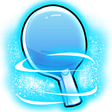Backhand reverse pendulum serve
Serving
Ian Hutchison Asked 11 months ago
There seems to be a backhand equivalent of most forehand serves, but I can't find anything on a backhand reverse pendulum. Is there such a thing?
 Alois Rosario Answered 11 months ago
Alois Rosario Answered 11 months ago
Hi Ian,
You're right in observing that many forehand serves have their backhand counterparts in table tennis. However, the backhand reverse pendulum serve isn't really defined.
I guess it would be performed from the forehand corner of the table and hit with the racket coming around the right hand side of the ball. Sounds complex. We might have to try and invent what this might look like.
The reverse pendulum serve, when executed from a forehand stance, involves an outward motion of the wrist and forearm, creating spin that moves from left to right (for a right-handed player). Trying to replicate this serve using a backhand grip can be quite awkward and technically challenging because it requires an unnatural twisting of the wrist and a less effective use of the arm and body. That said, it is theoretically possible to execute a backhand serve with a motion that attempts to mimic the reverse pendulum effect. This would involve using a very flexible wrist action and a significant amount of practice to master the unusual motion.
However, the effectiveness and spin generated might not be as pronounced as with the traditional forehand reverse pendulum serve.
Love the thinking outside of the box.
Recommended Video
Serving Secrets Introduction
A brief overview of what we'll cover in Serving Secrets series
Watch NowNo comments yet!
Become a free member to post a comment about this question.